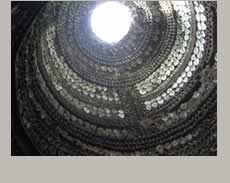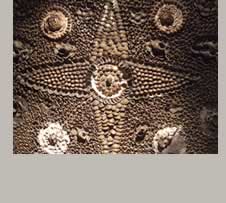






















 |
 |
 |
 |
|||||||||||||||
 |
 |
 |
 |
 |
||||||||||||||
 |
 |
 |
 |
 |
 |
|||||||||||||
 |
 |
 |
 |
|||||||||||||||
 |
 |
 |
 |
|||||||||||||||
The Grotto was first opened to the public in 1837, having been 'discovered' two years previously. At its heart is a central room with an encrusted tump that could be interpreted as an altar, approached down a passage and through a rotunda. The passages are qround eight feet high, and the length of the journey around eighty feet. In the central room an exit to the street has been boarded up. The surfaces of the Grotto are decorated with panels of shells deployed in all manner of ingenious patterns, always constrained within simple, clear frames, sinuous, mathematical and almost exclusively, like all Shell Grottos, symmetrical. The ground plan of the Grotto is in itself a magnificent conceit, with its polyp-like profile, and inadvertent resemblance to vegtabular or submarine extrusions. The occurence of a seance in the central room (see above) was an attempt to tap into the undoubted spookiness of the space. The Grotto is supported by English Heritage but is still in private hands. Touchingly there were attempts to clean the shells with their sticky patina of soot, but the trial shell disintegrated once the soot had been removed. The brochure with its complex iconographic programme is a useful distillation of all the fashionable mumbo-jumbo of our age, with its breathless celebration of the Universal, anthropomorphic scatterings of universal turtles and penises. There are many other Shell Grottos most notably the elegant example at Isola Bella, Lake Maggiore conceived in 1685. Perhaps the Margate Grotto dates from around the time of Alexander Pope's grotto in Twickenham.Other British examples that deserve mention are in Pontpool and at East Molesey. But Margate has the most ambitious and determined of surface decoration. It seemed to me to be the same sort of manufacturing philosophy as The House of Facteur Cheval, where daily contributions to the overall task were brought home at the end of the working day and added without inspiration or question to the overall programme, sometimes by the artisan and also perhaps by his uncomplaining children. The first owner of the Margate site had five children and I could well imagine them pressed into service as well as being sworn to secrey. My mother Marjorie, in her later years, covered plates, jugs, bottles, lamps and even our main fireplace with mussels, winkles and other shells bought by the sackfull and set in a sort of fast setting yellow curd. My father warned me never to sleep in her presence, lest I wake up encrusted. It is a common impulse in those with time on their hands. The antiquary Albertus Seba had a more inventive approach to Shell Design and patterning , but then he too had time on his hands. |